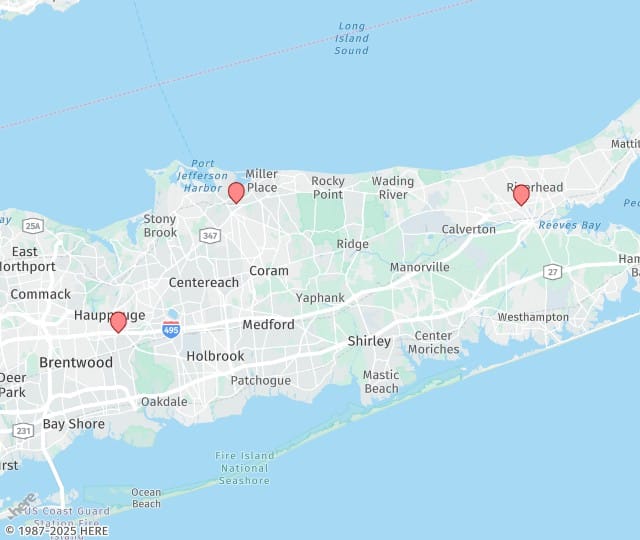An aneurysm, an abnormal bulge in the wall of an artery, can lead to life-threatening complications if not detected and treated early. These weakened blood vessel walls are at risk of rupture, leading to internal bleeding or clot formation. Early detection and treatment are critical to preventing severe health consequences.
At Suffolk Vascular & Vein Center, our board-certified vascular specialists bring decades of expertise in diagnosing and treating aneurysms. Our team includes Dr. Robert M. Pollina, MD, FACS, and Dr. Volodymyr Labinskyy, MD, who offers cutting-edge vascular care focusing on minimally invasive and complex surgical treatments.

Causes and Risk Factors of Aneurysms
While the exact cause of aneurysm formation is not always clear, several risk factors can contribute to its development, including:
Understanding these risk factors can help individuals take preventive measures to protect their vascular health.
Types of Aneurysms
Aneurysms can develop in various locations throughout the body, with the most common types including:
Each type of aneurysm requires careful monitoring and, in some cases, immediate medical intervention.
Symptoms of an Aneurysm
Aneurysms often develop silently, without noticeable symptoms. However, if an aneurysm grows or ruptures, symptoms may include:
Recognizing these warning signs and seeking immediate medical attention can be crucial in preventing severe complications and ensuring timely treatment.
Diagnosis and Treatment of Aneurysms
Suffolk Vascular & Vein Center uses advanced diagnostic imaging techniques such as CT scans, ultrasounds, and MRIs to detect and assess aneurysms. Treatment options vary depending on the size, location, and severity of the aneurysm:
Our specialists carefully evaluate each case to determine the best action for effective treatment and long-term vascular health.
The Dangers of an Undiagnosed Aneurysm
When left undiagnosed, an aneurysm can continue to grow, weakening the arterial wall over time. This increases the risk of severe complications, including:
Without proper screening and treatment, an undiagnosed aneurysm can result in life-threatening complications.
Why Choose Suffolk Vascular & Vein Center for Aneurysm Treatment?
Our highly trained vascular specialists at Suffolk Vascular & Vein Center provide expert care for aneurysms and other vascular conditions. We offer:
With a commitment to patient-centered care and cutting-edge treatments, Suffolk Vascular & Vein Center ensures that you receive the highest level of expertise for your vascular health.
Abdominal Aortic Aneurysm Treatment
An aneurysm is a localized, balloon-like expansion in a blood vessel caused by weak vessel walls. The aorta is the artery that carries oxygen-rich blood from the heart to the legs. When a bulge occurs in the abdominal section of the aorta, between the diaphragm and the legs, it is called an abdominal aortic aneurysm. Most aortic aneurysms occur in the abdomen, and most abdominal aortic aneurysms occur beneath the kidneys and may continue into the iliac, or leg, arteries.
Causes of Abdominal Aortic Aneurysm
Atherosclerosis, the narrowing of arteries due to fatty tissue accumulation, weakens vessel walls and is responsible for about 80 percent of aortic aneurysms. Other causes include:
Men are more likely than women to develop abdominal aortic aneurysms. Being over the age of 60 also increases one‘s chances of developing abdominal aortic aneurysms.
Symptoms of Abdominal Aortic Aneurysm
Abdominal aortic aneurysms may occur with no warning signs. Possible symptoms include:
Abdominal aortic aneurysms may be detected by manual examination by a physician, X-rays, ultrasound, CT scans, MR imaging and aortography.
Treatment of Abdominal Aortic Aneurysm
Surgery is recommended for arteries at great risk for rupture: those over six centimeters wide, and those four to six centimeters wide in patients otherwise in good health. Surgery is performed immediately on arteries that threaten imminent rupture or have already ruptured, although success is far less likely once the vessel has burst.
While an abdominal aortic aneurysm presents a grave danger, when it is repaired before rupture the prognosis is quite good. Recovery from the surgery, however, may take several months.
Traditional surgery involves making an incision to open the abdomen, then removing the aneurysm and replacing the excised vessel piece with a synthetic tube. Minimally invasive laparoscopic techniques require only small incisions, typically made in the femoral artery in the thigh, through which a thin tube with a camera is inserted so the surgeon can see inside the patient‘s body without the need for open surgery.
Risks of Abdominal Aortic Aneurysm
The weakened, bulging vessel walls are susceptible to rupture, a catastrophic event which causes severe bleeding and pain and is often fatal. Half of all untreated abdominal aortic aneurysms end in rupture and death within 5 years. Leakage rather than rupture may occur, causing blood to flow through the inner lining into the vessel wall, known as aortic dissection. Further, blood clots may form in the aneurysm and travel to other arteries, where they may block blood flow. Other complications are infection and blockage of the aorta.
Additional Resources
Take Control of Your Vascular Health
Early detection and treatment of aneurysms can prevent life-threatening complications. If you have risk factors or concerns about your vascular health, contact us in Port Jefferson Station at 631-476-9100, Hauppauge at 631-979-0222, or Riverhead at 631-591-9003.
